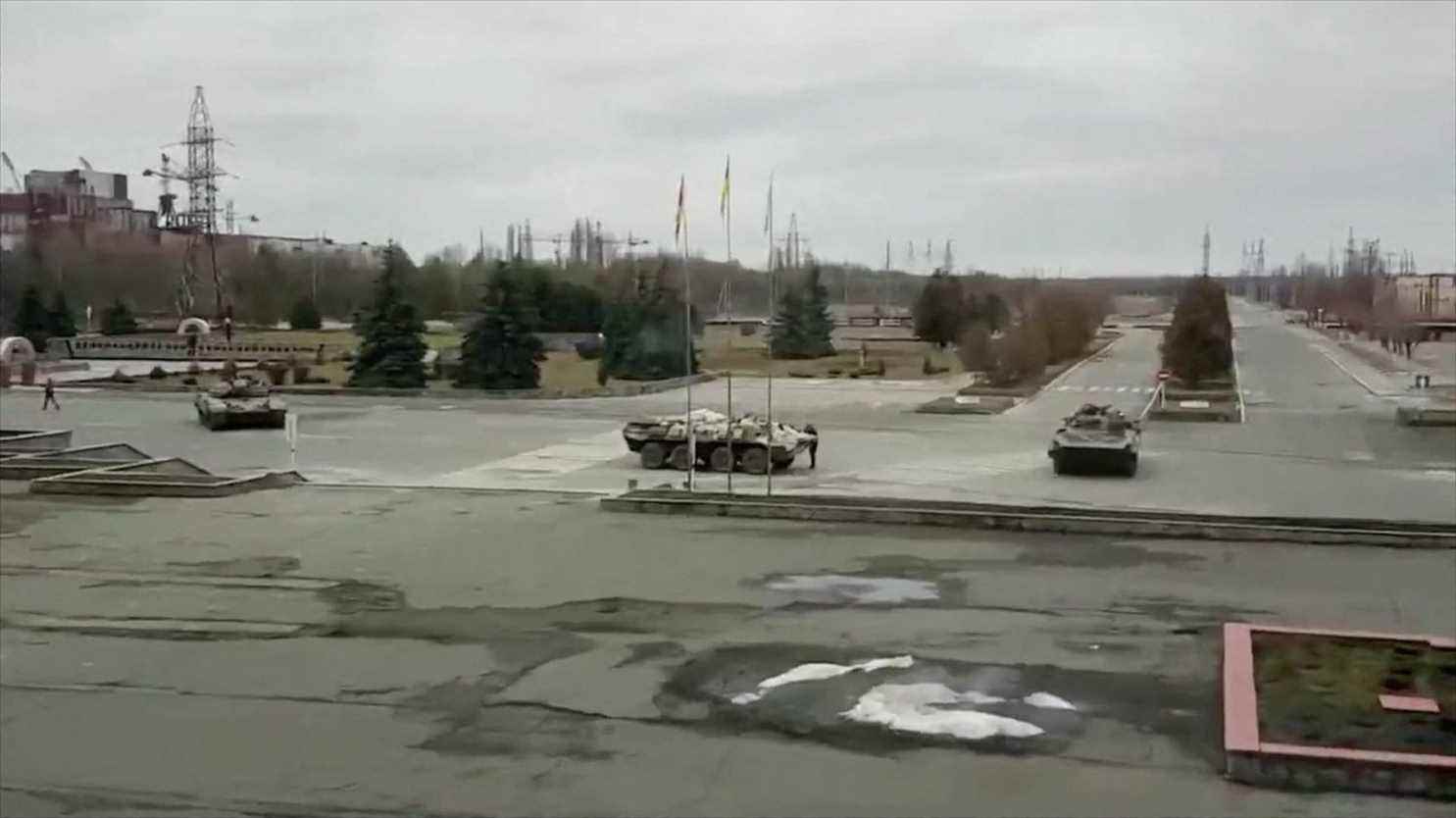Rising levels of radioactivity. This is the worrying observation tweeted by the Ukrainian Parliament, Friday February 25 (link in English). According to the institution, the limit levels of radioactivity “have been exceeded in a large number of places” of the Chernobyl exclusion zone in northern Ukraine. This protected site, which houses the former Soviet nuclear power plant which suffered a serious accident in 1986, came under the control of the Russian army early Thursday evening.
>> Follow the evolution of the Russian-Ukrainian conflict in our live
Forces present, dangerousness of the site, health risks: franceinfo summarizes the stakes of these fights, which concern up to theFrench Institute for Radiation Protection and Nuclear Safety (IRSN).
The site fell to the Russian army after heavy fighting
Shortly before 7 p.m. on Thursday, the Ukrainian presidency announced that the former nuclear power plant had been taken by Russian army soldiers. “After fierce fighting, we lost control over the Chernobyl site”said Mikhaïlo Podoliak, an adviser to the presidency, quoted by AFP.
Earlier in the day, Kiev reported fighting near the site’s nuclear waste repository. Ihe Ukrainian President, Volodymyr Zelensky, claimed that Ukrainian soldiers there “sacrificed their lives” to avoid a catastrophe like in 1986. Significant destruction of military equipment and various human tolls have been reported by both sides, without it being possible for the moment to verify them.
The area remains very dangerous, more than thirty years after the worst nuclear accident in history
The former Soviet power plant and its surroundings were declared hostile to human activity after the terrible accident of April 26, 1986, during which the plant’s reactor No. 4 exploded before melting. The radioactive discharges of this disaster have since caused thousands of direct and indirect deaths, as well as more than 6,000 thyroid cancers in children, estimates the Red Cross, which continues to assist the surrounding populations.
In total, the Chernobyl exclusion zone concerns a huge area, more than 2,200 km² in northern Ukraine and 2,600 km² in southern Belarus. The nuclear site itself, decommissioned in December 2000, includes a huge containment arch placed on the damaged reactor – as well as 20,000 m³ of radioactive waste, “solids and liquids”, reminds the IRSN in a note published on February 25.
Automatic statements are still being verified
In its report sent to the Ukrainian Parliament, the country’s Center for Nuclear Safety said it observed an increase in radiation levels on Friday morning from 6 a.m. (local time). In total, 21 lights turned red, out of the fifty automatic beacons in the exclusion zone on the Ukrainian side. Within the confines of the plant itself, four of the six active sensors recorded an overrun of the limit rates. Cautious, the Ukrainian Parliament clarified on Friday that it was “still impossible to establish the causes of these changes (…) because of the occupation [russe] and military combats in the area”.
Data from the automated radiation monitoring system of the exclusion zone, which is available online, indicate that the control levels of gamma radiation dose rate (red dots) have been exceeded at a significant number of observation points. pic.twitter.com/G4WEGgkMcT
— Verkhovna Rada of Ukraine (@ua_parliament) February 25, 2022
For its part, Moscow rejected these analyses, assuring that everything was under control. “The level of radiation around the nuclear power plant remains within its limits”said in a statement (in English) Major General Igor Konashenkov, spokesman for the Russian Defense Ministry. The Russian army has also certified that the teams of the plant continued to take care of the premises and to monitor the radioactivity. Are they taken hostage, as Jen Psaki, the White House spokeswoman, worried Thursday evening during a press conference? ? None of this information has yet been invalidated or confirmed by the Ukrainian agency Sauezm, in charge of the site.
If the increase in radioactivity on the site is debated, the reasons for the phenomenon mentioned by Kiev are also the subject of conjecture. Could it be leaks caused by bombardments, on waste storage areas for example? Or a spread of the contamination in the air, caused by the passage of military tanks? In its note of February 25, the IRSN said it was unable to refute or to confirm this information concerning “the increase in the radiological environment around the site”. “We must remain very cautious about these measures at this stage”recalls the institute.
European nuclear watchdogs remain on the lookout
While Russia seems to have locked its hold on Chernobyl, and is continuing its relentless advance on Ukrainian territory, the time has come for vigilance regarding possible radioactive releases caused by the fighting in the exclusion zone. The European Radioactivity Monitoring Network (Eurdep), created in the aftermath of the Chernobyl disaster, is based on more than 5,500 automatic stations in 39 partner countries, with readings that can be updated every hour in the event of an emergency. .
“No increase in radioactivity has been detected in European countries”, assured Friday the IRSN, which is part of this network. On the French side, the map generated from the Teleray monitoring system reported Friday evening levels of radioactivity well below the dangerousness thresholds established by the IRSN, including a majority of readings below the daily average. The same observation is made at European level, according to the interactive map provided by the European Commission.
